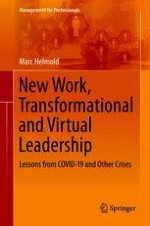2021 | OriginalPaper | Chapter
6. Transformational Leadership in New Work Organizations
Author : Marc Helmold
Published in: New Work, Transformational and Virtual Leadership
Publisher: Springer International Publishing
Activate our intelligent search to find suitable subject content or patents.
Select sections of text to find matching patents with Artificial Intelligence. powered by
Select sections of text to find additional relevant content using AI-assisted search. powered by
